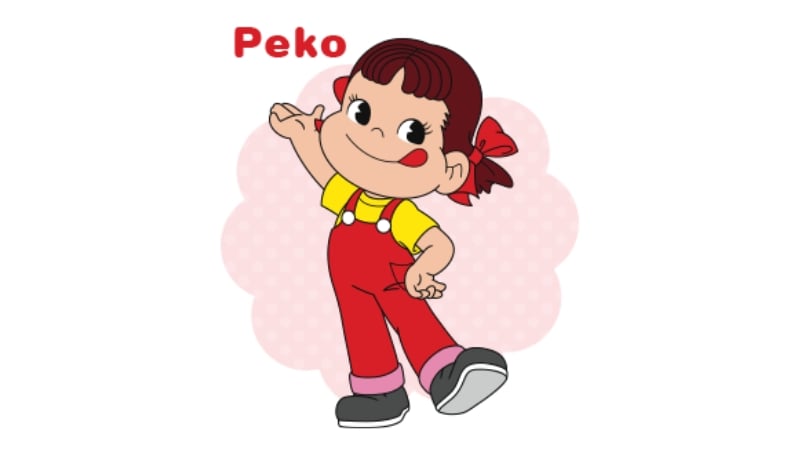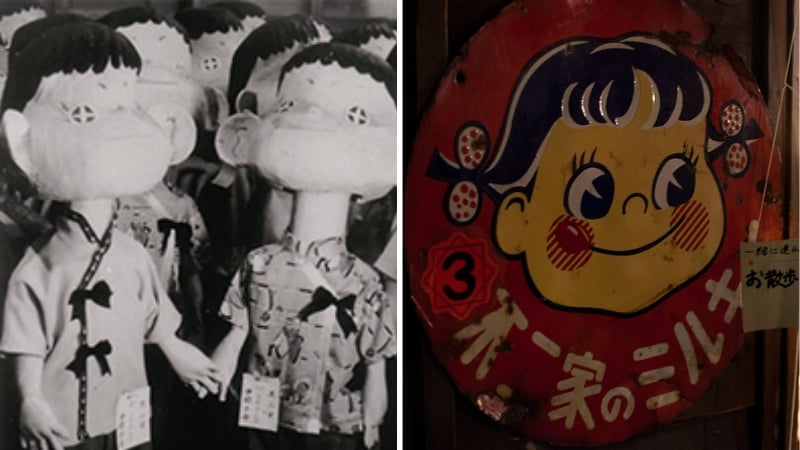If you’ve ever strolled past a local konbini or spotted an eye-catching poster on your morning commute in Japan, you’ve undoubtedly encountered Peko-chan. With her rosy cheeks and sparkling eyes, she radiates the charm of a carefree childhood. She is a familiar figure linked to Fujiya’s Milky soft milk treats. Yet behind that ever-adoring smile lurks an urban legend as quirky as it is chilling.
Also read: Top 5 Most Haunted Places in Tokyo, Japan
The Birth of a Beloved Figure

Image credit: Fujiya | Official Website
Peko-chan first emerged in 1950, a time when Japan was rebuilding its spirit after the hardships of war.
She was created as the cheerful face of a range of nostalgic confections. She quickly became an emblem of comfort and sweet indulgence. Over the decades, her image has transcended generations. She now graces everything from packaging and apparel to eye-catching advertisements across the nation. In every corner of Japan, her friendly visage is a reminder of a simpler, sweeter past.
A Haunting Legend: More Than Just a Mascot

Image credits (L-R): Fujiya | Official Website; Er Guiri | Flickr
However, beneath the layer of sugary innocence lies a startling urban myth. Contrary to her saccharine appearance, some say that Peko-chan is not an ordinary child at all. Legend has it that she is, in fact, an ageless spirit with an unquenchable thirst. However, that thirst is not for sweets, but for the very essence of life. Yep. HUMANS.
The macabre tale tells of a desperate famine, where a mother, driven by starvation, sacrificed part of herself (literally). She did so in a bid to sustain her child. The little girl, that is, Peko-chan, was unable to satiate her hunger. She is said to have turned on her mother, committing an act so gruesome that it stained her legacy with blood.
The urban myth surrounding Peko-chan is as rich in wordplay as it is in eerie detail. Her name is derived from “peko peko,” an onomatopoeic expression imitating the sound of an empty stomach. This reference is an apparent nod to her alleged bloodthirst. Moreover, some enthusiasts claim that rearranging the syllables of “Milky” can hint at a darker, more ominous phrase. This phrase (‘kill me’… yikes) is reminiscent of the tragic events in her backstory. Even the blush on her cheeks is not without its sinister interpretation: Some believe it to be the very mark of the grim feast she is said to have indulged in.
Peko-chan in Modern Popular Culture

Image credit: Stéfan Le Dû via Wikimedia Commons
Despite the chilling legends, Peko-chan’s image remains firmly entrenched in modern Japanese culture. Today, she is more than just a mascot – she is a cultural phenomenon. Her likeness adorns an array of merchandise, from soft toys to quirky apparel.
However, for us horror fans, it blends retro nostalgia with a hint of the macabre. Undoubtedly, this juxtaposition of sweetness and eeriness has captivated both locals and travellers alike, making her a compelling icon for anyone with an appetite for the unusual.
For those who fancy a closer look at this enigmatic figure, a visit to the Fujiya Peko-chan House is an absolute must. Situated at the Ginza Crystal Building in the heart of the Ginza district in Tokyo, this eclectic store offers a treasure trove of Peko-chan memorabilia. It’s a place where fans can indulge their curiosity, picking up everything from collectible dolls to uniquely packaged confections.
Embracing the Dark Charm
Whether you see her as a beacon of bygone days filled with sweet memories or as a symbol of a more sinister narrative, Peko-chan remains a fascinating paradox. Her story is a playful yet haunting reminder that even the most innocent faces can hide a dark secret.
So, the next time you savour a Milky treat at your local shop, take a moment to appreciate not only the delightful nostalgia but also the curious, eerie legend behind its mascot. Truly, this myth makes Peko-chan such an enduring part of Japan’s cultural tapestry.
Also read: Unique Things to Do in Japan: Experience a Day as a Japanese Student





